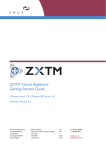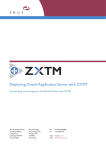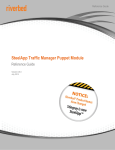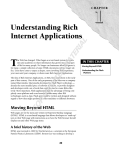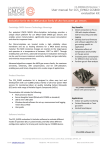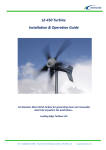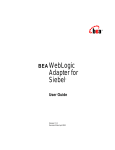Download Deploying PeopleSoft with Stingray Traffic Manager
Transcript
DEPLOYMENT GUIDE
Deploying PeopleSoft
with Stingray Traffic Manager
Using Stingray Traffic Manager with Oracle’s
PeopleSoft Enterprise Suite
Deploying PeopleSoft with Stingray Traffic Manager
Table of Contents
Introduction ................................................................................................................................................................................... 2
Why use Stingray Traffic Manager to manage PeopleSoft? ...................................................................................................... 3
Reliability .................................................................................................................................................................................. 3
Acceleration ............................................................................................................................................................................. 3
Security ................................................................................................................................................................................... 3
Management ........................................................................................................................................................................... 4
Deploying Stingray Traffic Manager with PeopleSoft ............................................................................................................... 4
Prerequisites ........................................................................................................................................................................... 4
Software Versions ............................................................................................................................................................ 4
Example Architecture .............................................................................................................................................................. 5
Basic Configuration ................................................................................................................................................................. 5
Creating the Traffic IP Group ......................................................................................................................................... 6
Creating Pools ................................................................................................................................................................. 6
Creating the Virtual Server .............................................................................................................................................. 7
Starting the virtual server ................................................................................................................................................ 8
Passing the Client IP address to WebLogic Server ................................................................................................................ 8
Enabling Session Persistence ................................................................................................................................................. 9
Monitor Application Cookies .......................................................................................................................................... 10
Transparent Session Affinity ......................................................................................................................................... 10
J2EE JSESSIONID cookies/URL .................................................................................................................................. 11
Load Balancing Algorithms ................................................................................................................................................... 11
SSL Offload ........................................................................................................................................................................... 11
Uploading your SSL private key and certificate to Stingray Traffic Manager ................................................................. 11
Configuring SSL Decryption .......................................................................................................................................... 12
Notifying WebLogic that the connection was encrypted ................................................................................................ 12
Running both HTTP and HTTPS versions of a website ................................................................................................ 12
Traffic Routing (Separation of static and dynamic content) .................................................................................................. 12
About Riverbed ........................................................................................................................................................................... 13
© 2011 Riverbed Technology. All rights reserved.
1
Deploying PeopleSoft with Stingray Traffic Manager
Introduction
Oracle's PeopleSoft Enterprise applications are designed to address the most complex business requirements. The PeopleSoft
Enterprise suite is a comprehensive set of enterprise applications covering a range of business needs. Riverbed® Stingray™
Traffic Manager is able to accelerate web-based PeopleSoft applications, making them faster, more reliable, more secure and
easier to manage.
Oracle’s PeopleSoft uses either BEA WebLogic or IBM WebSphere as its Application Server. We describe here the process for
integrating Stingray Traffic Manager with PeopleSoft using WebLogic.
Stingray Traffic Manager can improve the reliability of WebLogic applications such as PeopleSoft, double their performance (and
hence double ROI), protect them from direct attacks and flash floods, and dramatically reduce the operational costs in managing
servers and application upgrades.
© 2011 Riverbed Technology. All rights reserved.
2
Deploying PeopleSoft with Stingray Traffic Manager
Why use Stingray Traffic Manager to manage PeopleSoft?
Reliability
Stingray Traffic Manager provides a single point-of-entry to a PeopleSoft deployment served from a cluster of WebLogic servers.
With a combination of passive and active health monitoring and performance measurements, Stingray Traffic Manager can route
incoming requests to the fastest-responding servers and avoid servers that are failed or underperforming.
Request rate shaping ensures that your WebLogic servers can never be overloaded with requests, and advanced Session
Persistence reliably pins users’ sessions to individual servers for maximum reliability.
Acceleration
Stingray Traffic Manager has been proven to1:
• As much as double the transaction rate that can be achieved from WebLogic,
with no additional software or server tuning.
• Double the response speed, under sustained load from multiple clients.
• Provide over 15-times the SSL performance.
• Eliminate all errors for all but the most demanding tests.
Security
Total server isolation, request and response scrubbing, request validation and request rate shaping help to place your PeopleSoft
servers in as secure an environment as possible, protecting them from direct attacks from internet clients, invalid or malformed
HTTP requests and malicious or incidental flash floods that would severely impact the levels of service you provide.
Management
Stingray Traffic Manager’s advanced request routing and manipulation, driven by a fully programmable TrafficScript rules engine,
gives you full flexibility to manage both your network traffic and server resources:
• Route traffic over multiple domains, draining traffic from one domain to another
as applications are upgraded and user sessions complete.
• Load-balance over PeopleSoft servers and other servers to optimize resource
utilization and eliminate unnecessary load on your application.
1
Accelerating BEA WebLogic with Stingray Traffic Manager – an independent report by BroadBand Testing. http://www.riverbed.com/
© 2011 Riverbed Technology. All rights reserved.
3
Deploying PeopleSoft with Stingray Traffic Manager
• Drain traffic from individual PeopleSoft servers, so that they can be taken out of
service without any interruption to user’s sessions.
Deploying Stingray Traffic Manager with PeopleSoft
Prerequisites
Software Versions
• Stingray Traffic Manager: Stingray Traffic Manager version 4.0 or later is required
• PeopleSoft Enterprise, using BEA WebLogic Server: Stingray Traffic Manager may be used to manage traffic to
all versions of WebLogic Server. This document refers particularly to versions 8.x and 9.x.
It is assumed that the reader has followed the instructions in the Stingray Traffic Manager Getting Started Guide to install Stingray
Traffic Manager on one or more machines in front of a cluster of WebLogic Servers running a PeopleSoft service. For installation
and configuration of BEA WebLogic Server, please refer to the WebLogic Server documentation available from
http://edocs.bea.com/ for your version of BEA WebLogic. For installation and configuration of PeopleSoft, please refer the the
accompanying documentation.
Example Architecture
The diagram below shows a typical deployment of Stingray Traffic Manager with PeopleSoft. A pair of Stingray Traffic Manager
servers have been installed in front of two WebLogic application server clusters and a pair of web servers that serve static
content.
The examples given in the rest of this document will refer to this diagram, and will use the IP addresses specified in it.
The Stingray Traffic Manager servers are shown operating in active-active mode, using a pair of Traffic IP addresses (x.x.x.10 and
© 2011 Riverbed Technology. All rights reserved.
4
Deploying PeopleSoft with Stingray Traffic Manager
x.x.x.20). The DNS for the sites hosted by this architecture would list two A records (one for x.x.x.10 and one for x.x.x.20) for each
web site hostname.
Stingray Traffic Manager may also be configured to operate in active-passive mode; only a single IP address (x.x.x.10, for
example) would be required for each hostname.
Although two application server clusters have been shown here in order to demonstrate request routing, Stingray Traffic Manager
can be deployed in front of a single cluster. Similarly, a separate web-server cluster for static content is not essential, although it is
recommended in many deployments since it reduces the load on the application servers.
Basic Configuration
To prepare Stingray Traffic Manager for load balancing traffic across a PeopleSoft cluster, you must perform the following tasks:
1. Create a Traffic IP group
2. Create a pool for each WebLogic cluster, containing all the servers in the cluster
3. Create a virtual server, bound to the traffic IP group, that will listen on the appropriate port and send traffic to the pool
4. Start the virtual server
Begin by logging in to the Stingray Traffic Manager administration server.
Creating the Traffic IP Group
Go to Services > Traffic IP Group, and create a new traffic IP group, containing the external IP address(es) to which the
hostnames of your web sites resolve. The example group is named "weblogic_example".
Creating Pools
To create a new pool for your WebLogic servers, go to Services > Pool:
Enter a name for the pool, and a space separated list of nodes. Each node is defined as "hostname:port" where the
hostname is the hostname or IP address of the node, and the port is the number of the TCP/UDP port to which traffic should be
sent (e.g. "10.10.0.56:80" or "apps-1.localdomain:443").
Set the monitor to "Full HTTP".
Click "Create Pool"
© 2011 Riverbed Technology. All rights reserved.
5
Deploying PeopleSoft with Stingray Traffic Manager
The screenshot shows this being done for the two nodes in Apps Server Cluster A, which are listening on port 80.
Repeat this step for each pool of application servers and web servers you wish to load balance. With the example architecture,
two further pools would be configured as follows:
Pool Name: cluster_b
Nodes : 10.59.1.61:80 10.59.1.62:80
Monitor : Full HTTP
Pool Name: web_servers
Nodes : 10.59.1.31:80 10.59.1.32:80
Monitor : Full HTTP
Creating the Virtual Server
Go to Services > Virtual Servers:
In the Create a New Virtual Server dialog, choose a name for the virtual server, set the protocol to HTTP, and the port to 80 (this
is the port that Stingray Traffic Manager will listen on for incoming traffic).
Choose a default pool to send traffic to (in the example, this has been set to the cluster_a pool).
Click Create Virtual Server.
© 2011 Riverbed Technology. All rights reserved.
6
Deploying PeopleSoft with Stingray Traffic Manager
Once the virtual server has been created, you must edit it to make it use the traffic IP group you created earlier. Click on the edit
link to the right of the new virtual server's name. Under Basic Settings, click the Traffic IP Groups radio button, and select the
Traffic IP Group you've already created:
Starting the virtual server
To start the virtual server, return to the Stingray Traffic Manager Admin Server home page, and click the “play” icon next to your
newly created virtual server:
As created, this virtual server will load balance requests across the nodes in your WebLogic cluster using a round robin algorithm.
You should be able to test this by visiting one of the traffic IP addresses in your browser. You can use Stingray Traffic Manager's
activity graph to confirm that the load balancing is happening correctly.
Note, however, that since you haven't yet enabled session persistence, PeopleSoft won't work correctly. Enabling session
persistence is discussed later.
Passing the Client IP address to WebLogic Server
Since Stingray Traffic Manager is a proxy, all requests it sends to WebLogic will appear to come from the Stingray Traffic Manager
server's internal IP address (10.59.1.20 and 10.59.1.30 in the example). If the application needs to know the true client IP
address, Stingray Traffic Manager can pass it to WebLogic in an extra HTTP header. For WebLogic version 6.0 and later, this
header must be called "WL-Proxy-Client-IP"; for earlier versions, the header is called "X-Forwarded-For".
First, configure WebLogic to use the extra HTTP header by turning on the WebLogic Plugin Enabled setting in the WebLogic
administration server. If you are not sure how to do this, please refer to the documentation for your version of WebLogic Server.
© 2011 Riverbed Technology. All rights reserved.
7
Deploying PeopleSoft with Stingray Traffic Manager
Having done this, create a new TrafficScript rule in Stingray Traffic Manager to add the extra header, and enable it in the virtual
server for your WebLogic cluster as follows:
Go to Services > Virtual Servers > Your WebLogic Virtual Server, and click on the Rules link:
• Under Add new request rule, click Manage Rules in Catalog.
• In the Create new rule dialog. give the rule a name, such as weblogic_plugin, select the "Use TrafficScript language" radio
button, make sure that the "and associate it with ..." tick box is ticked
• Click Create Rule.
Cut and paste the rule below that corresponds to the version of WebLogic Server you are using into the rule box, and click Update
to create the rule.
WebLogic 6.x, 7.x, 8.x and 9.x:
$client_ip = request.remoteIP();
http.setheader("WL-Proxy-Client-IP", $client_ip);
Weblogic 5.x and earlier:
$client_ip = request.remoteIP();
http.setheader("X-Forwarded-For", $client_ip);
The rule will take effect immediately, and your Java applications that call HttpRequest.getRemoteAddr() will be given the true
client IP address.
© 2011 Riverbed Technology. All rights reserved.
8
Deploying PeopleSoft with Stingray Traffic Manager
Enabling Session Persistence
Before PeopleSoft will work correctly, it is necessary to enable session persistence; this causes the second and subsequent
requests from a client to be sent to the same back-end server as the first, which prevents server side session state being lost.
More recent versions of WebLogic share session state automatically between servers in a cluster; with these versions, enabling
session persistence increases the performance of the application by reducing the number of times session data must be
replicated between machines in a cluster.
There are three different types of session persistence that are appropriate for use with PeopleSoft:
• Transparent Session Affinity With this method, Stingray Traffic Manager simply inserts a cookie into the response header,
and uses this cookie to ensure that future requests received from the same client are sent to the same server as the first.
This method has the advantage that it is trivial to configure, but the disadvantage that PeopleSoft has no control over the
cookie (and so cannot unset it when the user logs out, for example).
• Monitor Application Cookie Stingray Traffic Manager can be set to monitor the JSESSIONID cookie that is set by
WebLogic. This has the advantage that PeopleSoft retains full control of the cookie.
• J2EE JSESSIONID cookies/URL (introduced in Stingray Traffic Manager 4.2) Both of the previous methods rely on the
client's browser supporting HTTP cookies. Since not all browsers support cookies, and some users disable cookies as a
privacy measure, WebLogic can be configured to add the JSESSIONID to the end of URLs in links generated by the
application, when it detects that the user's browser is refusing cookies. Stingray Traffic Manager can extract the
JSESSIONID from the requested URL, and use this as its session persistence key to ensure that sessions are persistent
regardless of whether the clients support cookies or not.
The Transparent Session Affinity method works simply with PeopleSoft, but all three methods are documented below for reference.
When using the Monitor Application Cookies or Transparent Session Affinity methods, session persistence must be enabled for
each of the pools that send traffic to WebLogic. In the example, therefore, it would be enabled for pools "cluster_a" and
"cluster_b".
Monitor Application Cookies
Go to Services > Pools > Your WebLogic Pool and click on the Session Persistence link. Click the Create New Session
Persistence Class link, and create a class named weblogic_cookie:
Set this class to Monitor Application Cookies and set the cookie name to JSESSIONID:
Leave the failure mode set to choose a new node to use. This will cause Stingray Traffic Manager to send the request to a
different node if the persistent node isn't available; in this circumstance, the chosen WebLogic server will recover a replica of the
session state from a secondary server; the end user should not notice that a failure has occurred.
© 2011 Riverbed Technology. All rights reserved.
9
Deploying PeopleSoft with Stingray Traffic Manager
As soon as you click Update, session persistence will be enabled for this pool. You can verify that it is working by looking at the
current activity graph as you browse one of the hosted websites. You should see that all the requests in a session are sent to the
same backend node. The recent connections page (Activity > Connections) can also be used to check that persistence is
working correctly.
Transparent Session Affinity
To enable Transparent Session Affinity, create a new session persistence class named "transparent", of type Transparent
Session Affinity, and set this as your pool's persistence class.
If you haven't created any session persistence classes already, the procedure is similar to that described in Monitor Application
Cookie section above.
If you've already created a class, then you must create the new class from the Catalogs > Persistence page, and then go to
Services -> Pool -> Your WebLogic Pool > Session Persistence to set the new class as your pool's session persistence class.
J2EE JSESSIONID cookies/URL
Configuring URL Rewriting Persistence is a simple process; Follow the same procedure as for Transparent Session Affinity, but
use J2EE JSESSIONID cookies/URL as the persistence class type.
Load Balancing Algorithms
By default, a newly created pool will use a simple round robin algorithm. This takes no account of the load on the back-end
servers, and so it is recommended that one of the more sophisticated algorithms is used. The optimal choice depends on the
application being run. See the Stingray Traffic Manager User Manual for details of each algorithm2.
The perceptive algorithm is a sensible default for a typical PeopleSoft deployment; set it on the Services > Pool-> Your
WebLogic Pool > Load Balancing page.
SSL Offload
Stingray Traffic Manager can decrypt SSL requests and send the resultant decrypted (plain HTTP) requests to PeopleSoft. This
reduces the load on the WebLogic servers, and permits Stingray Traffic Manager's session persistence and advanced content
inspection and rewriting features to be used with SSL traffic.
To enable SSL offload, you must first upload your SSL certificate and private key to Stingray Traffic Manager, and then configure
SSL decryption for the virtual server concerned. Finally, you must add a TrafficScript rule that will tell WebLogic that the
connection to the client was encrypted, so that applications can correctly test whether or not SSL was enabled, and WebLogic can
generate correct absolute links (beginning https://) where necessary.
2
Stingray Traffic Manager Documentation can be downloaded from http://riverbed.community.com/docs/
© 2011 Riverbed Technology. All rights reserved.
10
Deploying PeopleSoft with Stingray Traffic Manager
Uploading your SSL private key and certificate to Stingray Traffic Manager
If you have an existing SSL private key and public certificate, you can upload these files to Stingray Traffic Manager from the
Catalogs > SSL > SSL Certificates Catalog > Import Certificate page. Enter a name for the certificate pair (the combination of
private key and public certificate) and the paths to each of the files:
If you don't have an existing SSL certificate, you can create a new private key, self-signed certificate and certificate signing
request from the Catalogs > SSL > SSL Certificates Catalog > Create Self Signed Certificate page. Please refer to the
Stingray Traffic Manager User Manual for details.
Configuring SSL Decryption
To enable SSL Decryption, go to the virtual server configuration page for the virtual server concerned (e.g. Services > Virtual
Servers > Your WebLogic Virtual Server).
First make sure that the port and internal protocol are correct. The internal protocol specifies the protocol after SSL decryption and
so should be set to HTTP (the HTTPS protocol is used only when Stingray Traffic Manager is passing unencrypted SSL traffic
through to the back-end nodes). The port should be set as required; 443 being the standard HTTPS port. Update the configuration
if necessary.
• Click the SSL Decryption link. Set ssl_decrypt to yes, and choose an SSL certificate.
• Click the Update button at the bottom of this page.
Your virtual server will now accept and decrypt SSL traffic.
Notifying WebLogic that the connection was encrypted
Add the following rule to the virtual server. This sets the WL-Proxy-SSL header, which tells WebLogic whether or not the original
connection between client and Stingray Traffic Manager was encrypted. It's important to explicitly remove this header when the
connection isn't encrypted, so that remote clients can't trick WebLogic by adding the header themselves.
© 2011 Riverbed Technology. All rights reserved.
11
Deploying PeopleSoft with Stingray Traffic Manager
# Tell WebLogic if the connection to the client was encrypted
# and remove the Wl-Proxy-SSL header if not
if ( ssl.isSSL() ) {
http.setheader("WL-Proxy-SSL", "true");
} else {
http.removeheader("WL-Proxy-SSL");
}
Running both HTTP and HTTPS versions of a website
If you wish to run both an HTTP (unencrypted) and HTTPS (encrypted) version of your website, simply create two virtual servers
that use the same default pool, one set to listen to port 443, with SSL Decryption enabled as described in the preceding section,
and the other set to listen to port 80 with SSL decryption disabled. Remember to enable the TrafficScript rules for URL Rewriting
Persistence and Client IP Address Passthrough for both virtual servers.
Traffic Routing (Separation of static and dynamic content)
You can use TrafficScript to distinguish requests for static content from those for dynamic content, sending the former to your web
servers (.31 and .32 in the example architecture diagram) and the latter to one or more of your application server clusters.
The principle is straightforward - you write a TrafficScript rule that reads details of the request (usually the requested URL or Host
header) and uses these to decide which pool to send the requests to. Since the precise details of the rule will vary from
application to application, the following is given by way of example only.
To use this rule, you would first create new pools:
• Pool cluster_b contains the WebLogic servers in Application Cluster B (10.59.1.61:80 and 10.59.1.62:80)
• Pool static_servers contains your static web servers (10.59.1.31:80 and 10.59.32:80)
Session persistence for cluster_b would be enabled as for cluster_a; session persistence is not normally needed for static content.
Then add the rule below as the final request rule for the "weblogic_example" virtual server:
# URLs beginning /public/ are static, everything else is dynamic
$path = http.getPath();
# Send requests for anything other than dynamic content to
# the static cluster
if (! string.regexmatch($path, “^/public/”)) {
pool.use("static_servers");
}
# Split dynamic requests between the two application clusters, according
# to the host header - requests for it.example.com and sales.example.com
# are sent to cluster_a, all other requests to cluster_b.
$host = http.getHeader("Host");
if (string.regexmatch($host, "^(it|sales).example.com$")) {
pool.use("cluster_a");
} else {
# Everything else to the second application server cluster
pool.use("cluster_b");
}
© 2011 Riverbed Technology. All rights reserved.
12
Deploying PeopleSoft with Stingray Traffic Manager
About Riverbed
Riverbed delivers performance for the globally connected enterprise. With Riverbed, enterprises can successfully and intelligently
implement strategic initiatives such as virtualization, consolidation, cloud computing, and disaster recovery without fear of
compromising performance. By giving enterprises the platform they need to understand, optimize and consolidate their IT,
Riverbed helps enterprises to build a fast, fluid and dynamic IT architecture that aligns with the business needs of the
organization. Additional information about Riverbed (NASDAQ: RVBD) is available at www.riverbed.com.
Riverbed Technology, Inc.
199 Fremont Street
San Francisco, CA 94105
Tel: (415) 247-8800
www.riverbed.com
© 2011 Riverbed Technology. All rights reserved.
Riverbed Technology Ltd.
The Jeffreys Building
Cowley Road
Cambridge CB4 0WS
United Kingdom
Tel: +44 (0) 1223 568555
Riverbed Technology Pte. Ltd.
391A Orchard Road #22-06/10
Ngee Ann City Tower A
Singapore 238873
Tel: +65 6508-7400
Riverbed Technology K.K.
Shiba-Koen Plaza Building 9F
3-6-9, Shiba, Minato-ku
Tokyo, Japan 105-0014
Tel: +81 3 5419 1990
13

















